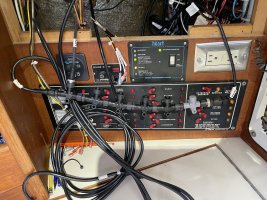I’m doing more rats nest cleaning and pulled my N2K backbone out from behind the panel. This looks curious to me. One end of the backbone has the wind instrument and an in-line terminator which I believe is correct.
The other has the plotter attached to the male end of the tee and the sounder to the normal drop cable attachment. Is there any reason that this could be correct?
I don’t have any major problems with the network. Only recurring issue is that the VHF loses our GPS position pretty regularly.
Our Garmin environment is pretty old but I’d like to keep it going. Here’s what we have on N2K:
GPSmap 4208
GWS 10
GMI 10
VHF 300
Airmar Tri Multisensor
Em-trak B954 AIS (new)
Pic attached. I’ve stripped off the power cable and all the drops except the ones in question.
The other has the plotter attached to the male end of the tee and the sounder to the normal drop cable attachment. Is there any reason that this could be correct?
I don’t have any major problems with the network. Only recurring issue is that the VHF loses our GPS position pretty regularly.
Our Garmin environment is pretty old but I’d like to keep it going. Here’s what we have on N2K:
GPSmap 4208
GWS 10
GMI 10
VHF 300
Airmar Tri Multisensor
Em-trak B954 AIS (new)
Pic attached. I’ve stripped off the power cable and all the drops except the ones in question.


